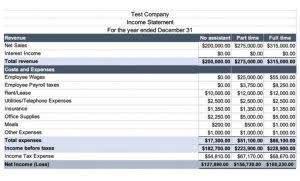
NWC is frequently used by accountants and business owners to swiftly evaluate the financial standing of a firm at any time. We can see in the chart below that Coca-Cola’s working capital, as shown by the current ratio, has improved steadily over a https://www.bookstime.com/ few years. Current assets are assets that a company can easily turn into cash within one year or one business cycle, whichever is less. They don’t include long-term or illiquid investments such as certain hedge funds, real estate, or collectibles.
Ways to Increase Net Working Capital
For both companies, the Change in WC is a fairly low percentage of Revenue, which tells us that it’s not that significant in either case. But Company A is in a stronger position because Deferred Revenue represents cash that it has collected for products and services that it has not yet delivered. Learn accounting, 3-statement modeling, valuation/DCF analysis, M&A and merger models, and LBOs and leveraged buyout models with 10+ global case studies. If you’re looking to supplement your working capital with a business loan, our partner Bluevine is a great option. You can submit a simple application with no impact to your credit, and receive a lending decision in as little as 24 hours. A decrease in cash, for example, after purchasing a new property or equipment, will decrease working capital; conversely, working capital will also rise when cash increases.
- This measurement is important to management, vendors, and general creditors because it shows the firm’s short-term liquidity as well as management’s ability to use its assets efficiently.
- Business executives usually aim for a positive net working capital, where current assets exceed current liabilities.
- While inventory is a current asset, it’s not as liquid as cash and you can often sell your inventory at a premium.
- In M&A transactions, net working capital is not just a financial metric, it is a strategic lever.
- If future periods for the current accounts are not available, create a section to outline the drivers and assumptions for the main assets.
How to Calculate Working Capital Cycle
Common examples of current assets include cash, accounts receivable, and inventory. Examples of current liabilities include accounts payable, short-term debt payments, or the current portion of deferred revenue. It’s a commonly used measurement to gauge the short-term financial health and efficiency change in net working capital of an organization. Working capital represents a company’s ability to pay its current liabilities with its current assets. This figure gives investors an indication of the company’s short-term financial health, its capacity to clear its debts within a year, and its operational efficiency.
- Conceptually, the operating cycle is the number of days that it takes between when a company initially puts up cash to get (or make) stuff and getting the cash back out after you sell the stuff.
- This ratio is expressed as a percentage, which tells you how much short-term money exists in relation to the business’s total money.
- Working capital is the amount of money that a company can quickly access to pay bills due within a year and to use for its day-to-day operations.
- If it experiences a negative change, on the other hand, it can indicate that your company is struggling to meet its short-term obligations.
- Jobs tend to be concentrated in agriculture (more than 20 percent), while much of their capital stock is in manufacturing and fossil fuel–based power.
- To help illustrate how the net-zero transition might play out differentially across the globe, we have defined six archetypes of countries according to the nature and magnitude of their exposure across sectors and households.
What Does the Current Ratio Indicate?
Keep in mind, this calculation is only one of many ways in which a company’s financial situation can be evaluated. You should take into consideration limitations and other ratios when determining the overall financial position of your business. Working capital is calculated by subtracting current liabilities from current assets. The current ratio, also known as the working capital ratio, provides a quick view of a company’s financial health.
- A business has negative working capital when it currently has more liabilities than assets.
- To calculate change in working capital, you first subtract the company’s current liabilities from the company’s current assets to get current working capital.
- Under sales and cost of goods sold, lay out the relevant balance sheet accounts.
- It demonstrates the number of short-term business assets that are available for a business to pay its short-term obligations.
- A healthy net working capital position suggests that a company is well-prepared to navigate economic challenges and withstand financial shocks.
Therefore, there might be significant differences between the “after-tax profits” a company records and the cash flow it generates from its business. Lauren McKinley is a Staff Writer at Fit Small Business, specializing in Finance. She’s a financial professional with over 4 years of diverse experience in the banking industry, primarily in the Northeast. Her expertise spans roles as a Credit Analyst, Loan Administrator, and Bank Teller, obtaining skills in commercial real estate, financial analysis, and banking operations. With a particular focus in small business financing, she has navigated financial solutions for a variety of lending institutions. It’s worth noting that if you make a major financial decision, such as taking out a loan or a lease for equipment, your NWC will be impacted in the near term.
How to Interpret Negative Net Working Capital

While this doesn’t always indicate financial health, businesses should manage their working capital carefully to have adequate liquidity and meet short-term obligations. Net working capital can offer insight into whether or not a company is able to meet its current financial obligations. By evaluating its current assets and liabilities, a company can determine if its NWC is positive or negative.
Is Negative Working Capital Bad?
Example of Working Capital and Cash Flow

